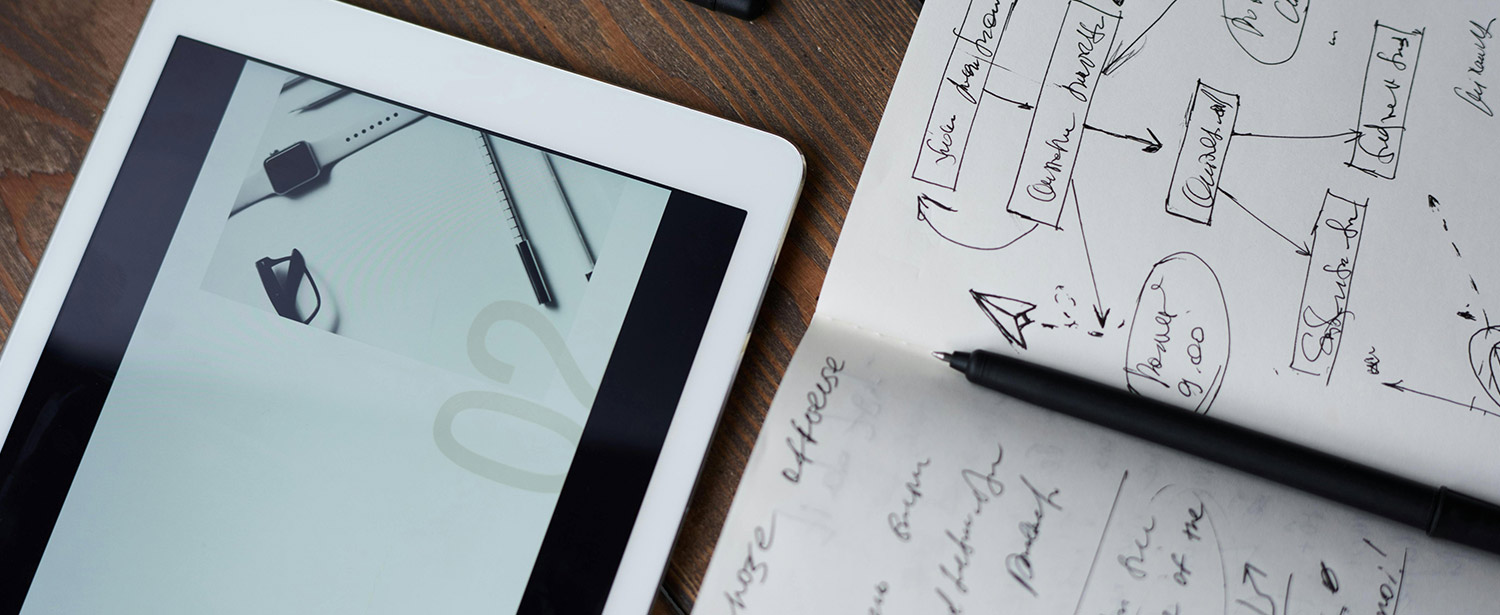The debate of Visual Communication vs UI/UX Design is like arguing whether characters or plots matter more in storytelling; they’re inseparable. Yet, for some reason, these terms are often treated as distinct, sometimes even competing, disciplines. This false separation creates confusion, especially for businesses looking to craft digital experiences that are both functional and perceivably compelling.
The reality? Visual Communication and UI/UX are interconnected disciplines. Hence, looking back at our initial example, a strong plot (visual communication) makes the story compelling, but without well-developed characters (UI/UX), the experience falls apart.
Great design, like great storytelling, needs both. You can’t have great UX without strong graphics, just as stunning design means little if users struggle to navigate it.
In this article, we’re not here to argue whether visual communication or UI/UX is better. Instead, we’ll unpack how these two disciplines complement each other — and how their strengths combine to shape more seamless, engaging digital experiences.
Defining Visual Communication and UI/UX
Before breaking down the intersection between visual communication vs. UI/UX, it’s essential to define both disciplines.
What is Visual Communication?
At its core, this focuses on conveying information through aesthetics – imagery, typography, colors, icons, and layouts. It focuses on appeal, branding, and ensuring that a message is pleasing to look at.
Common types of visual communication include:
- Typography & Layouts: Arranging text and elements for readability and appeal.
- Imagery & Iconography: Using graphics and symbols to create meaning.
- Color Theory: Leveraging color psychology to evoke emotions and guide attention.
A well-crafted hierarchy ensures that users know where to look first, what to focus on, and how to process information.
What is UI/UX?
While the former focuses on aesthetics, UI/UX focuses on usability, interaction, and overall experience.
- User Interface (UI): The look and feel of digital products, ensuring that different elements support user interaction.
- User Experience (UX): The overall journey of a user, making sure they can navigate and interact seamlessly.
Combined, UI/UX prioritizes functionality, ensuring that every decision enhances the user’s experience rather than just making things look good.
Intersecting Domains: Where Visual Communication Meets UI/UX
Since both these design disciplines share common ground, it is no surprise that they work hand in hand.
- Appeal + Usability
UI borrows heavily from graphic principles to create attractive and intuitive interfaces. - Enhanced UX
A well-thought-out design hierarchy improves readability, guiding users through an app or website effortlessly. - Consistency Across Touchpoints
Branding elements from a design perspective reinforce the emotional and functional experience of UI/UX.
Simply put, a UI/UX without strong illustrative elements feels uninspiring, while, in retrospect, an extremely appealing design without proper structure leads to confusion.
Divergent Focus Areas: What Sets Them Apart?
We’ve already established that instead of differentiating visual communication vs. UI/UX, it’s important to understand they’re both deeply connected. Each plays a distinct role in shaping user experiences. Hence, rather than working in isolation, they complement one another, ensuring products are both engaging and functional.
Visual Communication = Brand Storytelling & Emotional Engagement
- Shapes the aesthetic experience to evoke emotions.
- Establishes brand identity and recognition across platforms.
- Uses hierarchy to guide attention and meaning.
UI/UX = Functionality & Usability
- Ensures designs are intuitive, interactive, and problem-solving.
- Prioritizes user experience and accessibility for seamless navigation.
- Uses graphic elements purposefully to enhance usability.
The UI/UX principles of usability and interaction mean that graphic decisions are always tied to how users experience a product. Great digital experiences happen when both disciplines align—where storytelling enhances usability and usability optimizes the impact of graphics.
Industry Misconceptions: The Pitfalls of Prioritizing One Over the Other
A major reason why the visual communication vs. UI/UX debate even exists is that businesses view aesthetics and UI/UX as separate priorities—choosing style over usability or vice versa.
A product may be beautiful but frustrating to use or highly functional but visibly uninspiring. The best products strike a balance between both.
Mistake 1: Prioritizing Visuals Over Usability
It’s easy to get caught up in aesthetics—bold colors, high-impact graphics, and eye-catching animations. However, when these elements take center stage without considering navigation, the result is often a frustrating experience for users.
- Navigation challenges
A beautifully designed website without clear navigation forces users to struggle to find information, leading to drop-offs. - Overuse of animations and effects
Excessive motion graphics and flashy transitions can distract rather than enhance the user experience. - Accessibility concerns
Poor contrast, illegible typography, and overly complex layouts make it hard for users—especially those with disabilities—to interact with a product.
An appealing product means little if users can’t complete their tasks efficiently.
Mistake 2: Ignoring Visual Communication in UI/UX
Conversely, a product that functions perfectly but lacks strong design storytelling can feel uninspiring, generic, or even difficult to engage with.
- Weak typography and color choices
A well-structured app with bland colors or poor structure may not guide users effectively, reducing engagement. - Missed branding opportunities
Graphic storytelling plays a huge role in building emotional connections—without it, the product may feel disconnected from the brand. - Cognitive overload
If UI elements are purely functional but lack clear design cues, users may struggle to prioritize actions, leading to confusion.
Functionality alone doesn’t create an engaging experience—users connect with a product that speaks to them aesthetically.
Therefore, it’s important to strike the right balance between the two. The following section discusses how we do it.
Strategic Integration for Optimal Design Solutions
The key lies in blending aesthetics with usability, ensuring that graphic elements enhance functionality rather than compete with it. Here’s how to achieve this balance:
1. Prioritize Visual Hierarchy – Guide User Attention Where It Matters
A strong hierarchy helps users process information effortlessly. This means designing layouts that naturally lead the eye to key actions, content, and focal points.
- Use size, contrast, and spacing to make important elements stand out.
- Apply color psychology to reinforce brand messaging and create an intuitive experience.
- Ensure text readability by balancing typography, line spacing, and contrast.
When done right, a proper structure eliminates friction and makes navigation intuitive.
2. Align Aesthetics with Function – Design Should Support Usability
Great design isn’t just about looking good – it’s about working well. The best interfaces feel both engaging and effortless because their aesthetics support usability rather than distract from it.
- Buttons and interactive elements should be distinct in appearance but intuitive to use.
- Maintain consistency across touchpoints, ensuring that branding elements strengthen the user experience.
- Balance the whitespace and content so that users feel neither overwhelmed nor lost.
Every graphic component should serve a purpose—making interactions smoother, not more complicated.
3. Test, Iterate, Improve – Ensure UI and Visuals Work Together Effectively
Even the most well-designed interfaces need real-world testing. A product that looks great in theory may fail in practice if users struggle with navigation, readability, or interaction.
- Conduct A/B testing to compare different versions and see what resonates best.
- Gather user feedback to understand how visuals and UX elements influence interactions.
- Continuously refine the balance between aesthetics and usability to enhance engagement.
The best solutions are not just created—they evolve through testing and iteration.
Expert Perspective: The Designist Approach to Visual Communication & UI/UX
At Designist, we believe that great design isn’t about choosing between visual communication vs. UI/UX but understanding how they work together to create seamless, engaging, and user-centric experiences. By delving into the specialized roles of these disciplines, we ensure that every decision serves both aesthetic impact and functional clarity.
Why does this matter? Because businesses that treat visuals and UI/UX as separate silos often end up with beautiful but impractical products or highly functional but uninspiring interfaces. The real challenge – and opportunity – lies in integrating both disciplines effectively.
Through our expertise in visual storytelling, user behavior analysis, and design strategy, our team crafts digital experiences that don’t just look good but also drive engagement, usability, and brand connection. Whether it’s refining an app’s design hierarchy, optimizing a website’s usability, or ensuring a brand’s identity remains cohesive across digital platforms, our approach ensures that form and function are never at odds—they work in perfect harmony.
As design continues to evolve, businesses need a partner who understands design’s artistic and strategic sides. Our work is shaped by the questions that matter most—what users need, where businesses lose momentum, and how design can close that gap.




